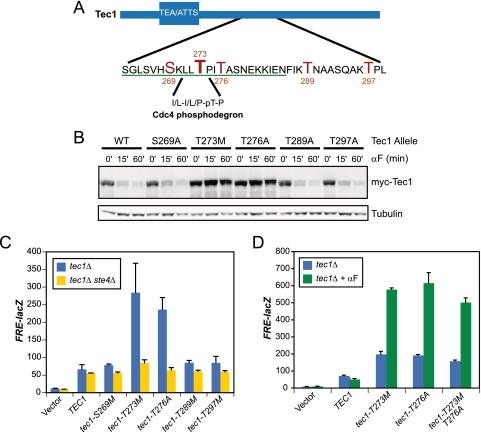FIG. 1.
Two phosphorylation sites on Tec1 are required both for mediating Tec1 degradation in response to pheromone and for maintaining signaling specificity. (A) Schematic of the region on Tec1 containing the residues identified as phosphorylated by mass spectrometry. Phosphorylated residues are indicated in red. The residues of Tec1 in the mutagenesis studies are underlined in green. The sequence of the previously identified Cdc4 phosphodegron (CPD) and its location are indicated. (B) Time course experiments of Tec1 phospho-site alleles. Immunoblot of extracts from tec1Δ cells expressing the indicated myc-epitope tagged allele from a centromeric plasmid. Cells were treated for the indicated amount of time with 5 μM pheromone before harvest. Immunoblot was probed with anti-myc and anti-tubulin (loading control) antibodies and was visualized by the LiCor Odyssey infrared imaging system. (C) FRE(TEC1)::lacZ expression in tec1Δ and tec1Δ ste4Δ cells transformed with the indicated plasmids. (D) FRE(TEC1)::lacZ expression in tec1Δ cells transformed with the indicated plasmids. Exponentially growing cultures were split, and 5 μM pheromone was added to one. Both were then grown at 30°C for two additional hours prior to harvesting of cells.

